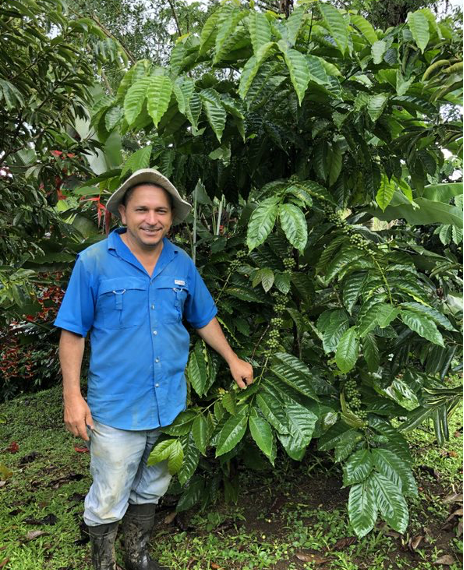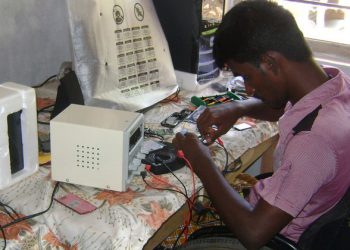Leer este blog en español
Your daily cup of coffee, and the 25 million smallholder farmers who produce all the cups of coffee like it, are in danger.
Why? Without adaptation measures, experts predict that by 2050 climate change will reduce by half the areas of the world suitable for coffee cultivation.
Yet, despite the threats of rising temperatures, irregular rainfall, and coffee pests and diseases, putting climate adaptation measures into action can change this reality for some regions, protecting vulnerable farmers.
New WRI research explores how people along the coffee supply chain can strengthen key advantages already present in one vibrant coffee growing region in Costa Rica. Coffee farming communities in Costa Rica face many of the same climate and profitability challenges as farmers in other major coffee-producing countries like Brazil, Colombia, Mexico, Guatemala, Honduras, Vietnam, Indonesia, Ethiopia and Uganda.
In many of these countries, the coffee industry will require fundamental changes to respond to climate change impacts. These changes go beyond small, short-term adjustments (like introducing heat-tolerant coffee varieties) to encompass more transformative investments and pathways for long-term adaptation and viability. When climate impacts are very severe and threaten the viability of staying in the coffee business, the whole system needs to be transformed. This can mean creating new business models, shifting where coffee is produced, or even switching to different crops.
Without adaptation measures, climate change will shrink Costa Rica’s suitable coffee-growing regions by 2050
The district of Coto Brus is in southeast Costa Rica, by San Vito. Green areas indicate increasing suitability by 2050 for growing coffee. (In Coto Brus, green areas tend to be located inside protected conservation areas and are not available for farming.) Grey areas reflect no change by 2050, while yellow and orange areas reflect decreases in coffee suitability. RCP stands for Representative Concentration Pathway, adopted by the UN to project the atmospheric concentration of greenhouse gases given a certain level of effort to reduce emissions. This figure shows a low emissions scenario (RCP 2.6) with low climate impacts, giving optimistic estimations of the change in coffee suitability. Use the map legend to toggle between different emissions scenarios.
Source: Ovalle Rivera (2018) suitability study, visualized on PREPdata.
Costa Rica has eight coffee-growing regions. The district of Coto Brus, located in the southeast and home to 3,000 coffee farmers, is one of the regions most vulnerable to climate change. Farmers there are already experiencing higher temperatures, more pests and disease, and erratic coffee flowering. Moreover, the higher-altitude areas that are projected to become more suitable for coffee growing are primarily inside nationally-protected conservation areas — meaning they are not available for agriculture.
Much work remains to be done, but Coto Brus has begun implementing adaptation measures that could be models for other places too. This region has several advantages in place that it can build on, to help coffee farmers and their communities increase resilience to climate change. These include: farmer associations and cooperatives; farmer-to-farmer knowledge exchanges; national and international programs for sustainable farming practices; and institutions that support coffee farmers and connect them with related partners or guidance. These institutions include public ones like government ministries and the Coffee Institute of Costa Rica (ICAFE), as well as non-governmental organizations, microfinance lenders, and agricultural research centers.
These kinds of initiatives are relevant for other coffee farming communities and countries too. The new WRI paper includes multiple recommendations and discusses all of these factors. Here, we focus on three specific areas where Coto Brus is bridging important gaps, and offer ideas on further strengthening climate change adaptation in those areas:
1. Bridge the Communication Gap, Ensuring Information Reaches Every Farmer
A number of institutions in Costa Rica provide information, financing opportunities and technical support to farmers for climate adaptation planning and action. However, farmers aren’t always able to access information easily from these institutions.

A farmer in Coto Brus grows and experiments with two different coffee varieties, to see which ones will provide higher yields and resilience. Photo by Stefanie Tye
Recognizing this need, ICAFE recently developed a mobile phone application called CR CAFÉ to more efficiently communicate with individual coffee farmers. This free and voluntary tool provides timely alerts for weather and pest outbreaks as well as suggestions on fertilizer and other inputs, provided directly by agriculture extension agents. Farmers can personalize their account with their farm’s size, annual yield and other characteristics.
ICAFE and the Ministry of Agriculture and Livestock could further expand the app’s features to communicate with farmers about expected climate impacts in their areas and provide adaptation guidance — for example, using other trees to provide shade and protect coffee plants from heat. CR CAFÉ could also support farmers interested in financing or certain types of technical support, and connect these farmers to microfinance institutions, public programs or others that can meet these needs.
2. Map the Shifting Viability of Coffee Production and Assess Options for Alternative Crops
Given the severity of climate impacts, coffee will not be viable everywhere it’s currently grown in Costa Rica, or in other coffee farming countries, over the coming decades. New areas might also become more suitable to coffee cultivation, particularly with advances in technology, agricultural practices and new varieties of coffee. At the government and industry level, it is essential to understand when and where coffee farmers may reach the limits of incremental adaptation and need to consider other crops entirely.
The Costa Rican Ministry of Agriculture and Livestock’s National Institute for Agricultural Technology and Transfer is piloting a suitability mapping project for 12 priority crops, including coffee, to identify the most viable locations for different crops based on weather, soil, water and land characteristics. Additionally, the team is working with the national Climate Change Office to integrate climate projections and understand how these crops may perform in the coming years as the suitability of various crops may shift to different locations.
This project could test how crop suitability mapping can inform long-term adaptation planning and help ensure that farmers and their communities transition in or out of coffee production as equitably as possible.
3. Expand Non-Traditional Financing Options for Climate Adaptation Measures
In Costa Rica, public, non-profit and private sources provide different forms of financing for adaptation measures on coffee farms. Most of the financing is through loans to replant aging coffee groves with newer, climate-resilient varieties that are more tolerant to higher temperatures or pests.
Despite the range of financing options, however, small producers are still largely underfunded, due to the lengthy, complicated processes and requirements demanded by some funders, and the risk of projects not succeeding. Locally based funders — like the microfinancing organization Gat Sur Alto and the National Institute for Rural Development, as well as the sustainable development organization Fundecooperación — are bridging this gap by providing training and assistance on investment and business plans, tracking of cash flows, and other areas, to ensure farmers are successful with their applications and their investments.
Traditional microfinancing options will likely be insufficient when it comes to promoting larger, industry-wide adaptation measures. In addition to traditional financing options, and international funding from entities like the Adaptation Fund, better climate adaptation would be facilitated by more diverse schemes. For example, revolving funds distributed by famer and credit cooperatives can provide a collective pool of funds available at low interest rates. Special government funds could incentivize and support farmers located in high-risk zones in transitioning to other crops or even other livelihoods, like ecotourism.
Early Planning for the Long Term Helps Protect Coffee Farmers From Climate Change
Costa Rica’s experience shows that government ministries, coffee cooperatives, farmers and the broader coffee community can work together to protect the industry against climate change. Planning now for current and future climate impacts can lessen the disruption, ensure the most vulnerable receive the support they need, and allow for the best use of scarce resources. This can help protect millions of coffee farmers and seasonal workers in coffee-producing countries — and your morning coffee.
Read WRI’s new paper to learn more about the key factors present in Coto Brus and recommendations to strengthen the coffee sector’s resilience in the face of new climate realities.



